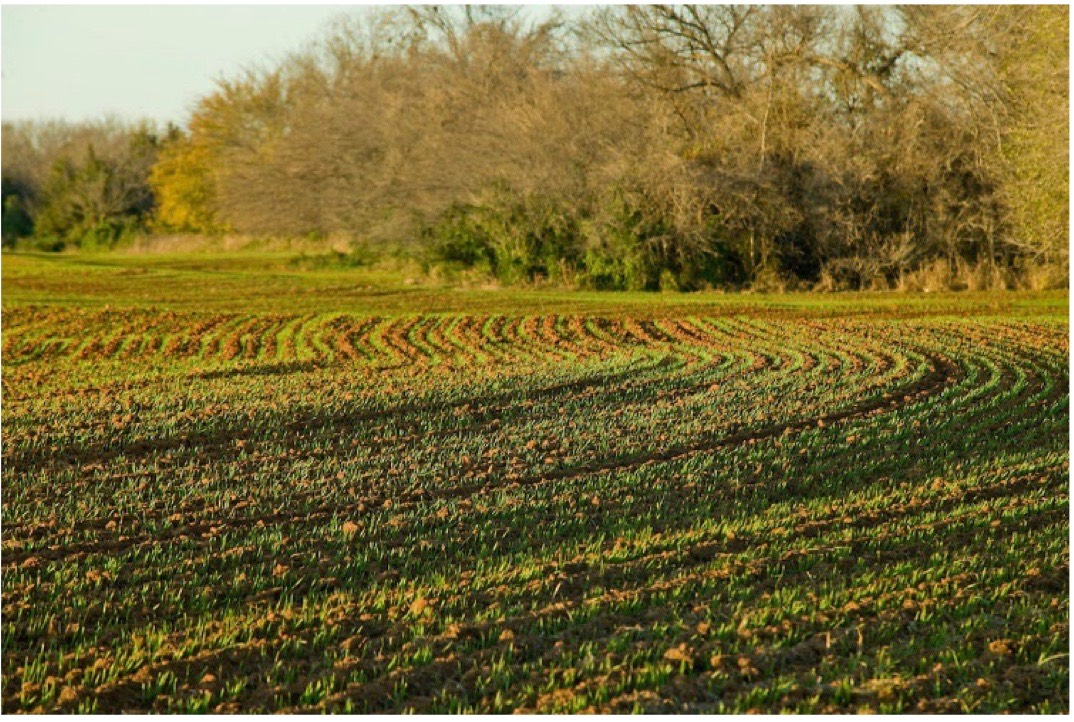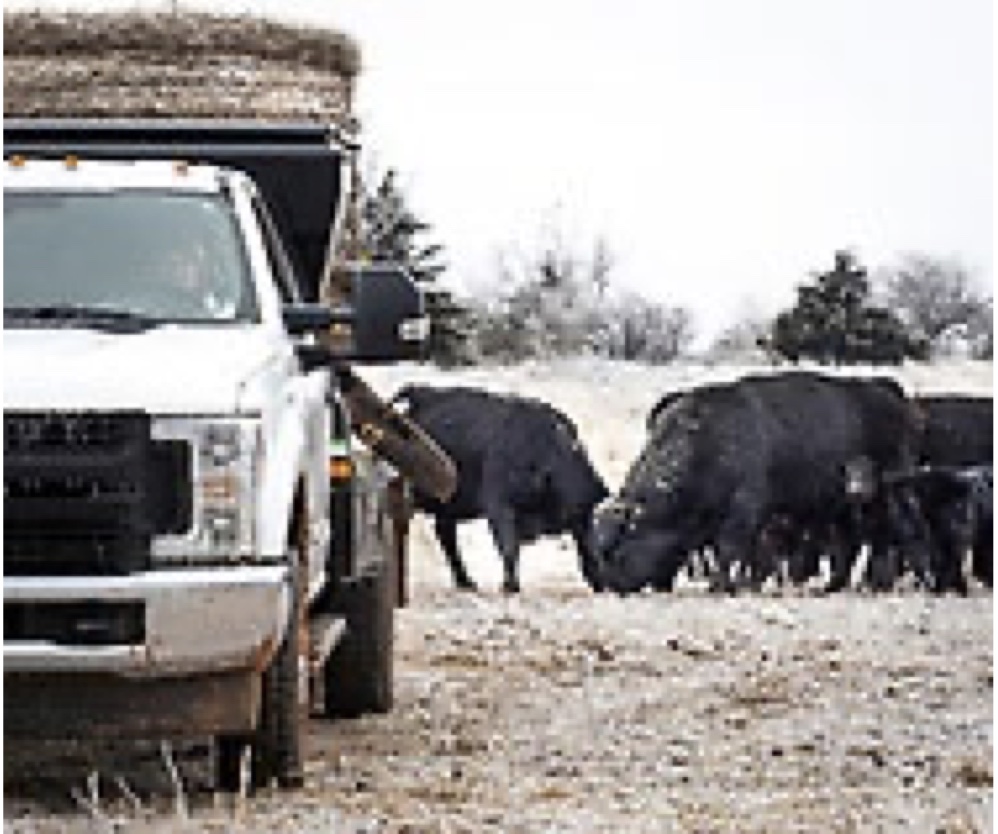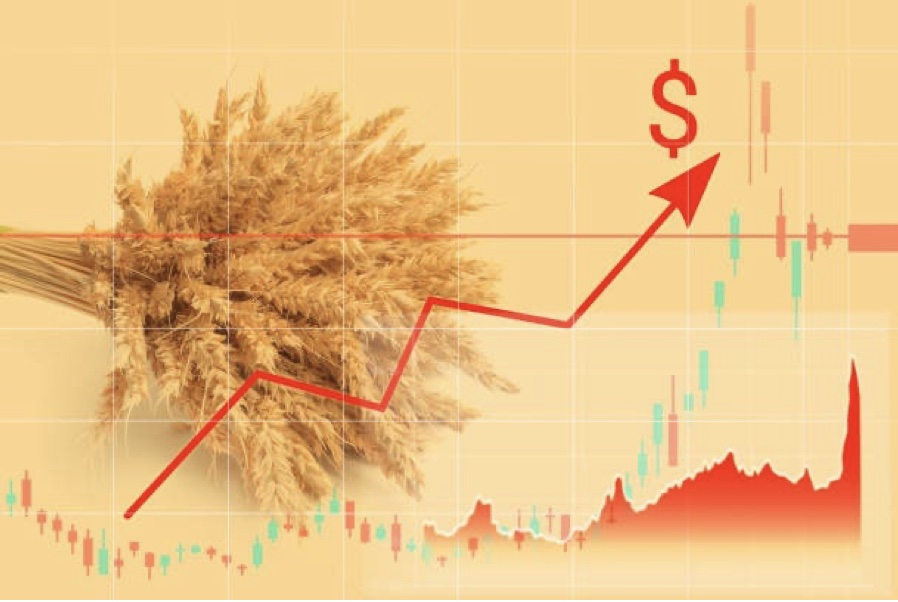Ag Insights January 2023
Tuesday, January 3, 2023
Spring Management in Wheat
Josh Bushong, West Area Extension Crops Specialist

Wheat is off to the races, albeit at a snail’s pace. The last USDA National Agriculture Statistics Service’s Oklahoma Crop Progress and Condition report for the month of November reported that 95% of the wheat has emerged. This is on par with the five- year average of 94%. The same report rated the crop at only 31% as good or excellent, which did improve from the beginning of November of 14%. While there isn’t much of fall wheat pasture this year, there still is an opportunity to make a decent grain crop.
October and November sown wheat has had a hard time getting up and going. October sown wheat likely stayed in the ground until the rain a week before Halloween. This was a saving rain, but it also dropped soil temperatures. The first half of November also brought colder than average air temperatures. The combination of cold rains and air temperatures dropped soil temperatures down into the mid 40’s. Ideally wheat needs at least a soil temperature of 54 degrees to germinate.
Delayed emergence from drought and now cold soil temperatures can have an impact on
potential grain yields. Wheat only needs at least 4-5 leaves and 1-2 tillers prior
to dormancy. In the fields I’ve been in most wheat plants are setting a second tiller.
Hopefully more leaves and secondary roots will develop before dormancy truly sets
in. Instead of making plans for heavy topdress nitrogen applications this winter or
even early spring, it might be wise to wait later into the spring to better estimate
grain yield potential.
As far as how late can wheat be topdressed with nitrogen, field research conducted by OSU the past four seasons has shown it might be later than your think. These grain- only trials have proven that topdress applications made 80-100 growing degree days after planting, typically early to mid-March, overwhelmingly yielded the same as early and late winter applications. Wheat quality, particularly grain protein, seemed to increase with later nitrogen applications as well.
This doesn’t mean to wait till the last minute to topdress, but this supports extending the window to apply nitrogen. Applying later in the season can increase nitrogen use efficiency. As the crop progresses, a better estimation of grain yield can be more accurately determined and topdress rates can be altered accordingly. If covering large acreage, wheat producers should initiate topdress applications sooner to allow enough time to get the job done especially if weather delays application.
Topdressing tank-mixed with a herbicide can be an economical option. Since the sprayer will be using a broadcast nozzle, such as a flat fan, Urea Ammonium Nitrate (UAN) rates should be limited to 10 to 20 gallons per acre depending on conditions. Applications should be avoided when air temperatures rise above 70° and relative humidity is low. Applications should be made prior to jointing stage, which will limit yield loss by allowing more recovery time if crop injury occurs.
Disease management has shown to have good yield savings over the years. If applied timely, most commercially available fungicides have had good yield protection in OSU field trials. If only one application is budgeted, it is best to apply late and protect the flag leaf. Long-term OSU data typically average about 10 to 20 percent higher yield compared to no fungicide.
Weeds have had the same issues as the wheat, but they are finally emerging and showing a presence in some fields. Since some didn’t receive rains prior to sowing wheat, terminating a first-flush of weeds wasn’t an option this year. The late emergence of weeds and wheat also means fewer farmers applied herbicides this fall. Timely spring herbicide applications and potentially harvest-aids in thinner stands could be expected.
Timely field scouting is the only way to determine if a pest is present and if an application of a herbicide, insecticide, or fungicide is warranted. The only way for one of these pesticides to protect yield and have a positive return on investment would be knowing what pests are present and knowing how much yield potential can be saved if applied correctly.
Cold Weather Nutrition for Beef Cows
Dana Zook, West Area Extension Livestock Specialist

Last year, I mentioned to my husband that I wished the weather was more characteristic of the season. “Be careful what you wish for,” he said. As I write this shortly before Christmas, it looks like Old Saint Nick will be sending weather from the North Pole so he will feel right at home while he makes his Christmas deliveries. As we move through this first cold snap and prepare for potential cold in January and February, let’s review additional nutritional requirements for cattle in winter weather.
There are many things that impact the ability of cattle to tolerate cold and inclement weather but haircoat and amount of moisture present (rain, sleet, ice, snow) play the biggest role. In addition, cattle in a body condition under five have less cold tolerance. All cattle will need extra feed to maintain body condition and manage this environmental stress, but those needs may vary from one group to the next.
So how much extra nutrition are we talking about? The Mesonet Cattle Comfort Advisor is an excellent tool for getting an idea of cold conditions and the impact they have on cattle performance. According to the Mesonet Cattle Comfort Advisor, a cow’s energy requirement increases 1% for each degree the index is below 32°. This energy need would double to 2% for each degree below 32° if the animal is wet to the skin. A good energy value to refer to is total digestible nutrients or TDN.
Let’s look at the forecast for a realistic example.
If our temperatures top out at 20 degrees and there is no moisture, cattle will need an additional 12% energy to maintain body condition (32°-20° = 12°; 12°x 1%= 12% added energy). Added moisture would cause the requirement to double to 24%. Remember we are talking energy supplementation, but producers could also just provide that additional requirement as total supplement for easier math.
So how much would producers need to feed to meet this increased requirement to gestating cows? On a normal day, a producer feeding a low-quality prairie hay (6% protein; 52% TDN) would need to feed 3 pounds of a 20% cube or 1.6 pounds of a 38% supplement to meet requirements. A dry cold of 20° would increase that daily feed amount to 3.33 pounds of a 20% or 1.8 pounds of a 38% supplement. Any moisture would double energy requirements increasing that feed to 3.72 pounds of a 20% and 2 pounds of a 38% supplement.
Keep in mind that increasing feeding allotments could cause some digestive upset if fed all at once. To prevent this, increase feeding at a lower level before cold weather strikes and for a few days after the cold snap to recover some energy loss. Also, cows that are fed just twice or three times per week may benefit from feeding more often to distribute higher feeding levels. A higher quality hay can also bridge the energy gap in these situations, but it is helpful to know the hay quality and how much is being provided.
For more information on Cold Preparations for Livestock, check out our recent episode of the OSU Extension Experience Podcast. Our podcast can be found on Apple Podcast, Google Podcast, Spotify and many other podcast platforms. You can also listen on our Spotlight blog.
Proactive Grain Hedging
Trent Milacek, West Area Extension Ag Econ Specialist

Wheat is growing well for many producers as rainfall events have increased in recent months. Markets went on a wild ride in 2022 with a new war, recession fears, inflation and monetary policy all influencing the agricultural industry.
Charting KC wheat over the past year reveals a low set on January 6, 2022, of $7.29/bu. and a high set on May 19, 2022, of $12.10/bu. The majority of price action around that high and low have occurred between $8.00/bu. and $10.00/bu. As someone who tries to manage risk and understand opportunities, it has been a difficult year.
The volatility in grain markets is always something that is a focus for management. With no hedging plan producers open their operation to market volatility. This can be profitable and disastrous depending on market moves. Naturally, the more financially stable the operation, the more risk that operation can sustain before becoming illiquid.
So, when is the best time to sell wheat? In 2018 it was August, 2019 in February, 2020 in December, 2021 in November and in 2022 it was May. Do you see a pattern? I certainly do not but I see another certainty, markets are difficult to predict. Given the volatility, a producer would have done well by selling wheat in every month of the year. True market averaging ensures that you are enjoying and wallowing in everything the market offers so there should be no fear of missing out, correct? However, ideally, we would like to have a more targeted approach.
The struggle to make money growing wheat is not unique to any generation. Nearby price action has helped improve revenue, but increased production costs keep margins tight. Knowing our cost of growing the crop gives us a marketing target that is based on keeping the farm in business. If the price is too low, we market less grain and if a price target is met, we unload grain to ensure that we remain profitable. Rarely does this strategy capture the tops of the market but it is a low risk and informed marketing strategy.
Many producers are reluctant to sell grain before it is harvested so it is difficult to take advantage of early season price action unless they store wheat across marketing years. Increases in storage costs have demanded that the market produce increased carry to support this decision. Carry (an increase in price across futures contract months) has been difficult to secure in a market that has desired grain to be delivered quickly and not stored. Therefore, producers not marketing early have had to time sales around unfortunate world events to profit from the open storage decision.
Consider your insurance guarantee, if you have a 70% revenue policy and an APH of 32 bu./acre, your current guarantee is 22.4 bu./acre. With a projected price of $8.79 for revenue crop insurance that is a guaranteed revenue of $196.90/acre. If you did not elect Harvest Price Exclusion (HPE), it is possible that your guaranteed revenue will increase as the harvest price could be higher if prices increase. Therefore, even if you have a crop failure, your insurance will guarantee that you will receive $196.90/acre.
Knowing this guarantee allows a producer to make forward contract marketing decisions. In the event of a crop failure, you may have to purchase undeliverable bushels on the open market to cover a forward contract. This is one of the major hurdles in getting producers to adopt forward contracts. However, if prices go up, the revenue crop insurance guarantee will also increase because the harvest price will be higher than the initial $8.79/bu. compensating for the more expensive bushels. If prices go down or stay the same as the initial price, revenue crop insurance provides $196.90/acre which will be enough to cover a conservative forward contracting strategy by using the crop insurance revenue guarantee.
There are some pitfalls to be aware of and avoid. Be sure to forward contract only a portion of your crop less than your guarantee that can be covered and do not become fully hedged up to your home-run bushel expectations. There is usually a delay when receiving an insurance indemnity as paperwork and field inspections must be carried out. If this delay lasts through the contract period, you may also need to secure outside funding to cover the buy-out of the contract in the short-term.
The aforementioned strategy is an innovative way to flex your insurance coverage and to secure these high prices without paying put option premiums or using futures contracts. Make sure you seek guidance before implementing such a strategy and discuss your plan with your insurance agent to make sure you understand exactly how your selected policy will cover you. There are many different insurance products and all possible scenarios cannot be discussed in this writing.
The point I hope to leave you with is to think about selling decisions. It is easy to become overwhelmed in the business and not leave time to work on it. If you do not feel comfortable marketing your grain, seek assistance from your coop or grain merchandiser. The supply chain works together and many of us pay for guidance from crop scouting to machinery repair, why not take a hard look at marketing as well?
Over-the-Counter Antibiotics Moving to Prescription Antibiotics
Barry Whitworth, DVM, Area Food/Animal Quality and Health Specialist for Eastern Oklahoma
The development of antimicrobial drug resistance in human medicine is a serious public health concern. For this reason, the United States Food and Drug Administration (FDA) promotes the judicious use of antimicrobial drugs in human medicine (CDC, 2021). As well as promoting the judicious use of antibiotics in human medicine, the FDA also promotes the judicious use of antibiotics in animals. The Guidance for the Industry # 209 (GFI #209) outlines the FDA’s thoughts on how to use antimicrobial drugs in food/animals in a judicious way. Two concepts of GFI #209 are that antimicrobial drugs should only be used for animal health and that these drugs should be used under veterinary supervision.
Following GFI # 209, the FDA finalized GFI # 213. This guidance led to the Veterinary Feed Directive. This document stated that antimicrobial drugs used in feed or water for animals should only be used for prevention, control, and treatment of disease. This resulted in several antimicrobial drugs switching from over-the-counter (OTC) drugs (note: as the name implies, OTC drugs can be purchased without a prescription) to veterinary feed directive drugs (VFD) or prescription drugs (Rx). In keeping with the FDA’s thoughts, this required veterinary oversight.
With the implementation of the Veterinary Feed Directive in January 2017, the majority of food/animal antimicrobial drugs are now being used for prevention, control, and treatment of disease under the supervision of a veterinarian. To address the few remaining OTC food/animal antimicrobial drugs, the FDA finalized the GFI # 263 in June of 2021. This document provided the framework for the pharmaceutical industry to voluntarily change the remaining medically important food/animal OTC antimicrobial drugs to Rx drugs. This continues the FDA’s policy of using medically important antimicrobial drugs for animal health and under the supervision of a veterinarian. This change will take effect in June of 2023.
Livestock producers need to be aware that injectable OTC antibiotics, oral forms of OTC antibiotics, and intramammary OTC antibiotics will no longer be available without a prescription from a veterinarian. Many of these products such as tetracycline, penicillin, and sulfur drugs are commonly used on farms and ranches. To obtain these products after June 2023, livestock producers will need a veterinary prescription. This will require a relationship with a veterinarian. A veterinarian-client-patient-relationship (VCPR) is defined by the Oklahoma Board of Veterinary Medical Examiners as:
- The veterinarian assumes responsibility for making medical judgments regarding the health of the animal based on a current thorough medical knowledge of the animal(s).
- Such knowledge is gained by recently seeing or being personally acquainted with the keeping and care of the animal to the extent necessary to properly make appropriate medical decisions.
- The veterinarian must keep readily accessible, written medical records of his/her knowledge and treatment of the animal with sufficient detail to clearly explain the initial exam and enable another veterinarian to take over treatment of the animal based on such records.
- The veterinarian must provide for some form of after care in case an emergency occurs after said care is provided; and the veterinarian's actions would conform to applicable federal law and regulations.
Now is the time for producers to begin to prepare for the changes in status of the OTC drugs. In preparing for the changes, a producer should have a good working relationship with their veterinarian. Producers should take an inventory of the antimicrobials that they are currently using. Producers should take that list to their veterinarian and learn what information will be needed to get a Rx for that product or products. Producers need to prepare early to avoid any interruptions in getting those products.
For livestock producers that have a relationship with a veterinarian, very little will change in June. However, for livestock producer who do not use a veterinarian, obtaining antibiotics for their animals after June 2023 will require the establishment of a VCPR. For more information about the change in status of OTC food/animal antibiotics, livestock producers should consult with their veterinarian and/or their Oklahoma State University Cooperative County Agriculture Extension Educator.
Extension Experience – Insights into Oklahoma Agriculture
The Northwest Area Extension Staff would like to announce the creation of our new podcast Extension Experience. The Extension Experience podcast is brought to you by Josh Bushong, Trent Milacek, and Dana Zook. Each week they provide perspective on Agriculture topics and offer insight from our experience working with Extension Educators and Producers across Oklahoma.
The Extension Experience podcast is available on Spotify, Google Podcasts, and Apple Podcast platforms. You can also access the episodes on spotlight.
